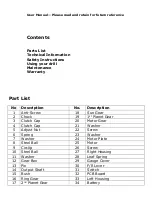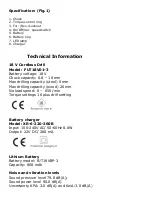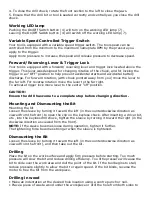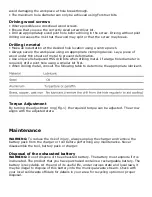
4. To close the drill chuck, rotate the front section to the left to close the jaws.
5. Ensure that the drill bit or tool is seated correctly and centrally as you close the drill
chuck.
Working LED lamp
Pushing the On/Off Switch button (4) will turn on the working LED lamp (7).
Leaving the On/Off Switch button (4) will switch off the working LED lamp (7).
Variable Speed Controlled Trigger Switch
Your tool is equipped with a variable speed trigger switch. The tool speed can be
controlled from the minimum to the maximum nameplate RPM by the pressure you
apply to the trigger.
Apply more pressure to increase the speed and release pressure to decrease speed.
Forward/Reversing Lever & Trigger Lock
Your tool is equipped with a forward/ reversing lever and trigger lock located above the
trigger. This lever was designed for changing rotation of the chuck, and for locking the
trigger in an “OFF” position to help prevent accidental starts and accidental battery
discharge. For forward rotation, (with chuck pointed away from you) move the lever to
the far left. For reverse rotation move the lever to the far right.
To activate trigger lock move lever to the center “off” position.
CAUTION:
Ensure the drill has come to a complete stop before changing direction.
Mounting and Dismounting the Bit
Mounting the bit
Loosen the sleeve by turning it toward the left (in the counterclockwise direction as
viewed from the front) to open the clip on the keyless chuck. After inserting a driver bit,
etc., into the keyless drill chuck, tighten the sleeve by turning it toward the right (in the
clockwise direction as viewed from the front).
NOTE: If the sleeve becomes loose during operation, tighten it further.
The tightening force becomes stronger when the sleeve is tightened.
Dismounting the Bit
Loosen the sleeve by turning it toward the left (in the counterclockwise direction as
viewed from the front), and then take out the bit.
Drilling
Place the bit on the work surface and apply firm pressure before starting. Too much
pressure will slow the bit and reduce drilling efficiency. Too little pressure will cause the
bit to slide over the work area and dull the point of the bit. If the tool begins to stall,
reduce pressure slightly to allow the bit to regain speed. If the bit binds, reverse the
motor to free the bit from the workpiece.
Drilling in wood
• Make an indentation at the desired hole location using a centre punch or nail.
• Place a piece of waste wood under the workpiece or drill the hole from both sides to


































